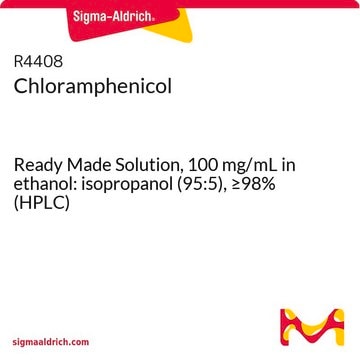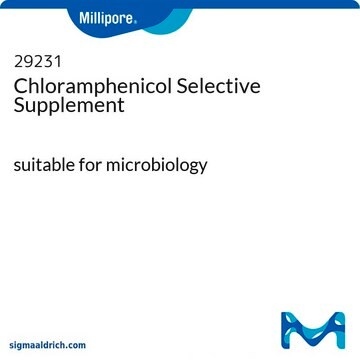220551
Chloramphenicol
Chloramphenicol, CAS 56-75-7, is a synthetic bacteriostatic antibiotic that inhibits the translation of RNA by blocking the peptidyltransferase reaction on ribosomes.
Synonym(e):
Chloramphenicol
About This Item
Empfohlene Produkte
Qualitätsniveau
Assay
≥97% (by Assay)
Form
crystalline powder
Hersteller/Markenname
Calbiochem®
Lagerbedingungen
OK to freeze
Farbe
gray to off-white
Löslichkeit
water: 2.5 mg/mL
methanol: 35 mg/mL
ethanol: soluble
Versandbedingung
ambient
Lagertemp.
10-30°C
InChI
1S/C11H12Cl2N2O5/c12-10(13)11(18)14-8(5-16)9(17)6-1-3-7(4-2-6)15(19)20/h1-4,8-10,16-17H,5H2,(H,14,18)
InChIKey
WIIZWVCIJKGZOK-UHFFFAOYSA-N
Verwandte Kategorien
Allgemeine Beschreibung
Biochem./physiol. Wirkung
Translation der RNA
Sonstige Hinweise
Lu, J. und Jiang, C. 1993. Biochem. Biophys. Res. Commun.196, 12.
Saltarelli, M.J., et al. 1993. Virol.197, 35.
Holt, J.T. 1992. Ann. N.Y. Acad. Sci.660, 88.
Maniatis, T., et al. 1989. In Molecular Cloning, A Laboratory Manual, Second Edition. Cold Spring Harbor, NY, p. 1.6, A.6.
Rechtliche Hinweise
Signalwort
Danger
H-Sätze
Gefahreneinstufungen
Carc. 2 - Eye Dam. 1 - Repr. 2
Lagerklassenschlüssel
11 - Combustible Solids
WGK
WGK 3
Analysenzertifikate (COA)
Suchen Sie nach Analysenzertifikate (COA), indem Sie die Lot-/Chargennummer des Produkts eingeben. Lot- und Chargennummern sind auf dem Produktetikett hinter den Wörtern ‘Lot’ oder ‘Batch’ (Lot oder Charge) zu finden.
Besitzen Sie dieses Produkt bereits?
In der Dokumentenbibliothek finden Sie die Dokumentation zu den Produkten, die Sie kürzlich erworben haben.
Kunden haben sich ebenfalls angesehen
Verwandter Inhalt
MILLIPLEX® genotoxicity assays enable high-throughput measurement of DNA damage, reducing time and cost.
Unser Team von Wissenschaftlern verfügt über Erfahrung in allen Forschungsbereichen einschließlich Life Science, Materialwissenschaften, chemischer Synthese, Chromatographie, Analytik und vielen mehr..
Setzen Sie sich mit dem technischen Dienst in Verbindung.







